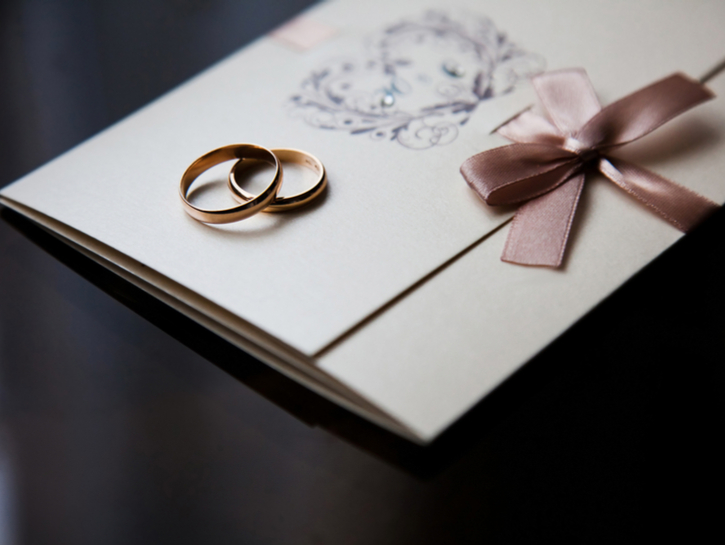Planning your wedding can be arduous — you have to tackle everything from the guest list and booking a location to the tiny details like centerpieces and the menu. One of the early stages of wedding planning is creating your save the dates, but where to begin? Look no further — we’ve got the guide for everything you need to know regarding save the date etiquette.
When Should I Send Save The Dates?
First of all, are save the dates a wedding requirement? They’re a tradition, yes, but you don’t have to send them if you don’t want to. However, your wedding guests tend to appreciate an in-writing heads up about the festivities rather than just informally being told the date. So no, save the dates are not a requirement for your wedding, but they are often preferred by your guests.
When figuring out a time to send out your save the dates, it’s important not to send them with too little notice, but not send them so far in advance that your guests forget about the event or misplace their save the date. For local weddings, the general rule of thumb for sending save the dates is at least six months before the big day.
For destination weddings, you want to send save the dates much earlier so your guests have time to plan for traveling. Send destination wedding save the dates about nine months to a year before “I do.”

ALEX KOLECHKIN/Shutterstock
Can I Send An Electronic Invite?
In this electronic age, people often opt for digital means over the traditional. For save the dates, it depends on what you prefer — you can definitely send your save the dates via email, though people might think physical copies are classier.
An easy balance of the digital and physical is to send simple save the dates in the mail with your wedding website URL in them. That way, your guests can be directed to all the important information online. Popular wedding websites people use are The Knot, Wedding Wire, and Joy.

oneinchpunch/Shutterstock
What Should I Put On My Save The Date?
So you’ve decided to send out save the dates — now what? What should you put on it?
It’s important not to overthink it. Save the dates do not need to be complicated. Start with listing the basic information about your wedding:
- The date of the event
- The general location; listing just the town or city will do for now
- The full names of the couple
- The URL for your wedding website, if applicable. Make sure your website is finished and running glitch-free before you send out your save the dates.
- A note that says “invitation to follow.” It’s important that your guests know this is not the formal invitation.

Phimsri/Shutterstock
How Should I Design My Save The Date?
Starting your design can be daunting, but there is no “right” way to create your save the dates. They can be formal or casual, and you can design them however you want.
Because you are sending your save the dates so far in advance of the big event, they don’t need to coordinate perfectly with your wedding decor. So don’t get strung up on what colors to use or what font would look best.
The only important thing to think about during the design process is making it personal. You don’t want your guests to open your save the date and not immediately know whose wedding it is for. An easy way to personalize your save the date is by adding some photos of you and your fiancé — either ones you’ve taken together over the course of your relationship or ones from an engagement photo shoot if you did one.

Ekaphon maneechot/Shutterstock
Who Should I Send Save The Dates To?
Send your save the dates to everyone who is for sure invited to the wedding. Though your guest list can change before you send out the final invitations, you can’t send a guest a save the date but not send them an actual invite. Along with your guests, you should send save the dates to members of your wedding party as well.

fizkes/Shutterstock
What Is The Difference Between Save The Dates And Invitations?
So what’s the difference between a save the date and a wedding invitation? Part of it has to do with when each is sent. The save the dates are sent months in advance of the wedding, while invitations are sent only about two months before the event.
Unlike the optional save the dates, sending invitations is a necessary step in planning your wedding. The invitations are much more detailed. Along with the information on your save the dates, invitations should have all the specifics your guests need to know, including:
- Hotel information for out-of-town guests
- The ceremony’s location and the location of the reception, if they’re different
- A more detailed timeline of the events — the rehearsal dinner, the ceremony, the reception, provided transportation (if applicable)
- Menu options
- RSVP information
When addressing the invitation, it’s important to list the name of everyone invited. So if you’re sending it to a family, list those who are invited so your second cousin’s girlfriend’s best friend doesn’t think that they can tag along. If you’re giving someone a plus-one, indicate that clearly by addressing it to, “Their Name and Guest.”

KiryIV/Shutterstock
